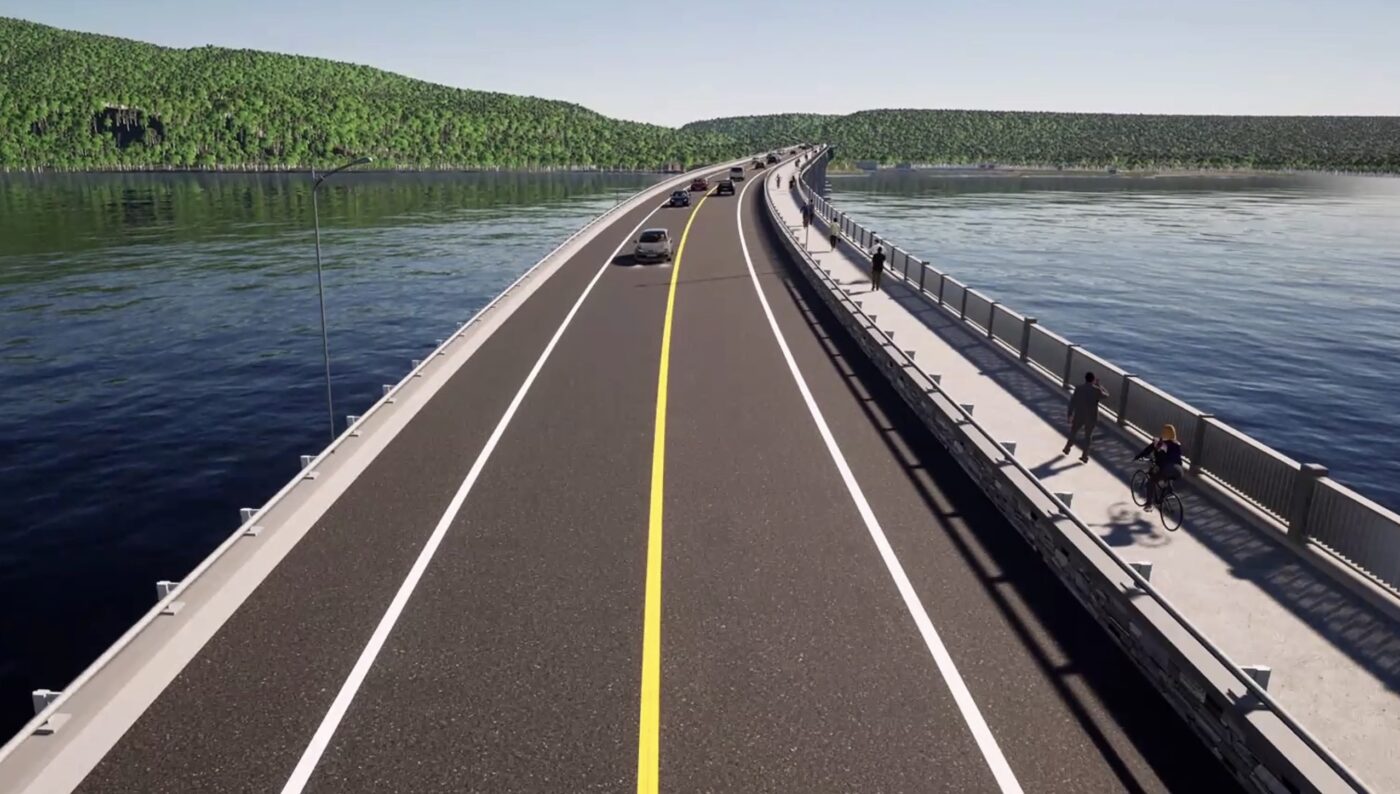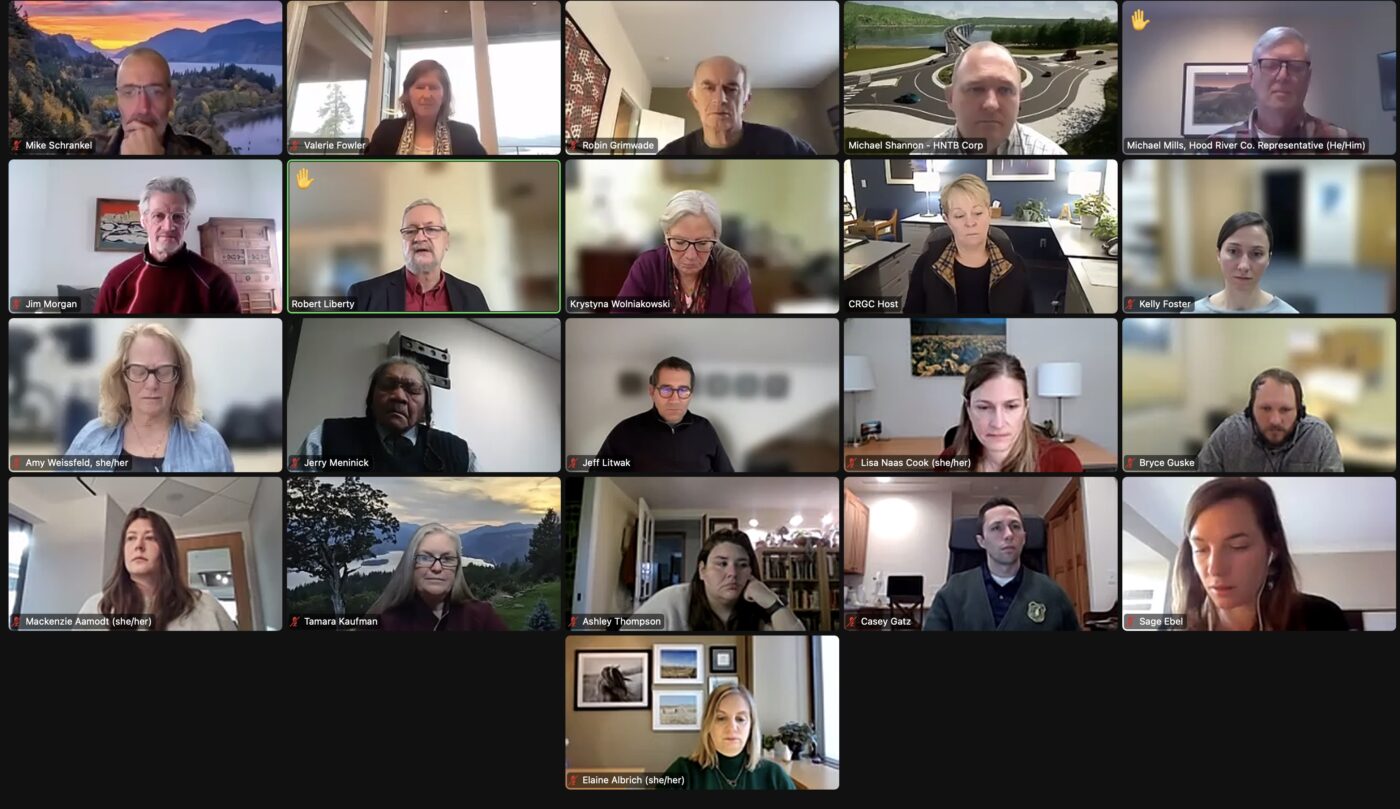The contours of conversations about how much space should be given to various users of the new Hood River-White Salmon Bridge are quickly coming into focus. Members of the Columbia River Gorge Commission where given an update on the project this morning and some of them see a red flag in the lack of space initially allocated toward non-car users.
Washington and Oregon have decided to spend an estimated $520 million to replace the current bridge because it’s over 100 years old, is quite narrow, and has no dedicated space for bicycling or walking.
Planning work began in earnest in 2018 and BikePortland first covered the project in 2020 when it reached a major planning milestone. From the get-go, some advocates worried that the conceptual design language called for only one 12-foot-wide path to serve two directions of cycling, walking, and other non-car users. That one path would be adjacent to 40 feet for drivers who would have two, 12-foot lanes and two 8-foot wide “breakdown” shoulders (so people could move aside and let traffic get by in the event of a fender-bender or other emergency).
The Gorge Commission was shown a presentation by Michael Shannon, a project manager with HTNB Corp, an engineering consulting firm. Shannon shared a new digital video of a conceptual rendering of what the future bridge could look like.
After seeing the presentation, Commission member (and former Metro Councilor) Robert Liberty raised his hand. He highlighted the management plan for the project that mandates the new bridge, “shall include facilities for pedestrians and bicyclists that are be wide enough to safely accommodate and encourage walking, bicycling and other uses.” Liberty then explained that a standard width for bike lanes on bridges is five feet in each direction and another five-to-six feet for pedestrians.
“So that’d be 15 to 16 feet, but the rendering and the cross-section state 12-feet. When the [Historic Columbia River Highway] bike trail on the [Oregon] side is completed, the volume of traffic is going to be considerable,” Liberty said. He then painted a picture of bike riders mixing with walkers and groups of people posing for a family photo.
In response, Shannon said it’s a challenge to balance all the needs of the project with a fixed budget. He added that the width of the bike path has been a “topic of discussion” and he assured Liberty that the designs shown today are merely at an early, 5-10% level of detail. “There will be more design refinements to look at on that,” Shannon promised.
Shannon also acknowledged that bridge engineers have flexibility when it comes to lane widths. He said they could consider adjusting the width of the shoulders to give more room to the path. Another option he mentioned was creating a bike lane on the main bridge deck that’s, “More geared toward e-bikes or the professional road users who don’t really like to be mixed in with the pedestrians and casual recreational users.”
It’s unclear why Shannon referred to some cyclists as “professional road users.”
The project currently has $119 million in the bank ($80 million from Washington, $25 million from Oregon, $14 million from federal government) and needs $400 million more — including $105 million from Oregon.
The current estimate for the bike/walk path is about $50 million.
While Liberty appears to be ready to champion a significant increase in the width and quality of the path, two members of the public who spoke during the open comment period shared a different perspective.
“The main purpose of this bridge is to move cars. It’s not to move people and bikes and everything else,” said a commenter named Mary (who also objected to the planned tolls that will help maintain the bridge). “It’s a crossing that is needed for economic reasons, but its main purpose is moving cars and trucks to keep commerce going.”
Another woman agreed with Mary, saying, “The principal responsibility of the bridge is to move traffic, it’s not to be the Golden Gate Bridge or whatever… it is for the most movement of transport and commerce and people who want to move from one side of the Gorge to the other for purposes of returning home from shopping or moving visitors to the area from one side to the other. I can’t imagine that a lot of people are going to be stopping at one side of the bridge or the other to take a photo.”
Shannon said the project hopes to have a final environmental impact statement and official “record of decision” from the federal government by spring of next year. Construction would then begin in fall 2025 with the final design in place by the end of 2026. The new bridge is expected to open in late 2029.



